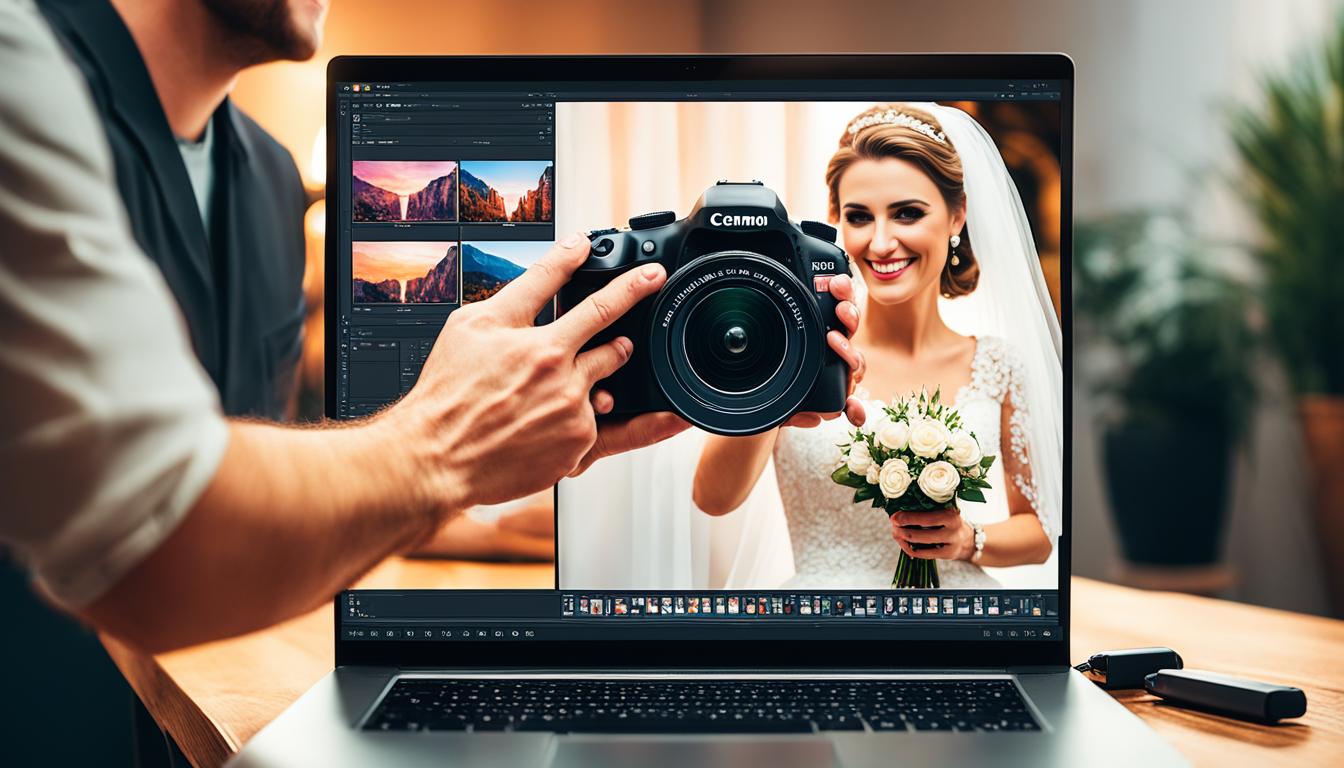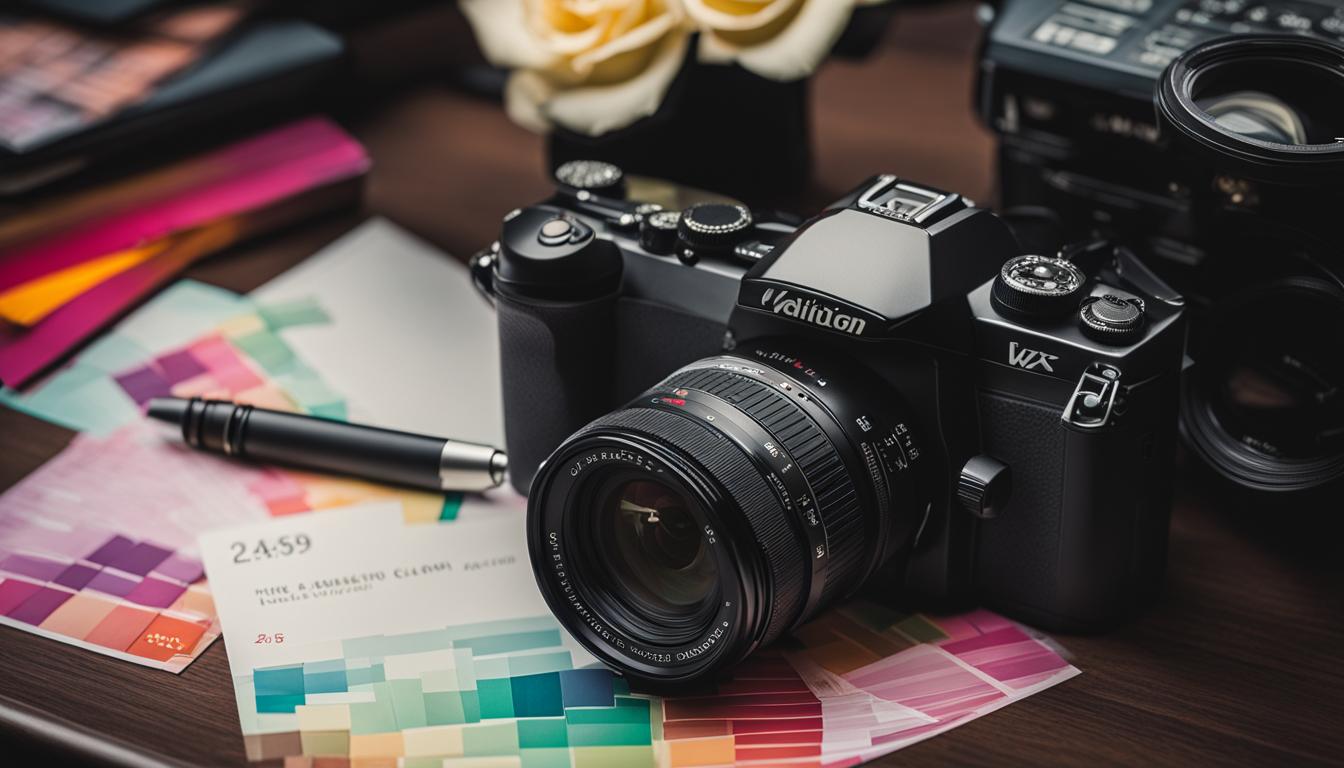At the heart of every successful wedding photography business lies an efficient editing workflow. As wedding photographers, we understand the importance of delivering beautifully edited images to our clients while maximizing our time and productivity. From wedding photo editing to post-production and the image retouching process, optimizing our workflow is essential in providing a seamless experience for both us and our clients.
By incorporating smart editing tools, utilizing effective photography workflow software, and implementing workflow optimization techniques, we can significantly streamline our editing process and enhance our photo editing efficiency. This allows us to spend more time shooting, collaborating with clients, and growing our business.
As wedding photographers, we know that the true magic happens not only behind the lens but also during the editing phase. Let’s explore the key steps, tools, and techniques that can help us optimize our editing workflow and take our wedding photography to the next level.
Key Takeaways:
- Optimizing your editing workflow is crucial for wedding photographers to save time and maximize efficiency.
- Incorporate the right editing tools and photography workflow software for seamless post-production processing.
- Implement workflow optimization techniques to streamline your editing process and enhance photo editing efficiency.
- Consider automated editing solutions to speed up the post-production process and maintain consistent quality.
- Outsourcing photo editing tasks can be a game-changer, allowing you to focus on other aspects of your business and deliver high-quality images to clients efficiently.
The Importance of Post-Processing in Wedding Photography
Post-processing plays a crucial role in the world of wedding photography. It involves manipulating and enhancing digital photographs using specialized photo editing software, allowing us to correct imperfections, enhance colors, and create high-quality images that leave a lasting impression on our clients. The power of post-processing allows us to take a raw image and transform it into a stunning masterpiece.
Through post-processing, we have the ability to manipulate photos in various ways. We can crop and straighten the image to create a visually pleasing composition. We can adjust the exposure and correct any color imbalances, ensuring that the final image looks vibrant and true to life. We can also retouch the photo, removing any blemishes or distractions that may take away from the overall aesthetic. Additionally, we can add text or graphics to personalize the image and make it truly unique.
Post-processing is more than just correcting imperfections and enhancing colors; it’s about unleashing our creativity and adding our own personal touch to each photo. It allows us to bring out the emotions and beauty captured during the wedding day, showcasing our artistic vision and creating images that evoke a sense of joy, love, and happiness.
With post-processing, we can create a cohesive collection of images that are consistent in style and tone. We can enhance the colors to make them pop, ensuring that every detail in the photo is visually appealing. By correcting imperfections and fine-tuning each image, we can deliver a final product that exceeds our clients’ expectations.
Our commitment to creating high-quality images goes hand in hand with our dedication to post-processing. It’s not just about taking great photos on the wedding day; it’s about using our editing skills to refine and elevate those photos into something truly extraordinary. Post-processing allows us to showcase our expertise and deliver a final product that truly reflects our artistic vision.
Next, we’ll explore the use of Lightroom in our wedding photography workflow and how it can help us achieve our post-processing goals. But before that, let’s take a moment to appreciate the transformative power of post-processing with an image that showcases the magic of enhancing colors and correcting imperfections.
In the image above, we can see the remarkable difference post-processing can make. The before and after comparison demonstrates how manipulating and enhancing a photo can transform it from ordinary to extraordinary.
“Post-processing allows us to turn a good photo into an exceptional one, capturing the essence and beauty of the moment in a way that leaves a lasting impact on our clients.”
**Table: Post-Processing Techniques**
| Technique | Description |
|———————-|————————————————————————–|
| Cropping | Adjusting the composition of the image by removing unwanted elements. |
| Color correction | Ensuring accurate and vibrant colors in the final image. |
| Exposure adjustment | Balancing the light and dark areas of the photo for optimal exposure. |
| Retouching | Removing blemishes and distractions to create a flawless look. |
| Adding text or graphics | Personalizing the image and adding unique elements. |
Using Lightroom for Wedding Photography Workflow
When it comes to editing wedding photos, Lightroom is the go-to software for wedding photographers. With its comprehensive range of tools and features, Lightroom empowers us to create stunning images that truly capture the essence of each wedding day.
One of the standout features of Lightroom is its non-destructive editing capability. This means that we can make changes to our photos without altering the original image file, giving us the freedom to experiment and try different editing styles without the fear of permanently damaging the original image. We can enhance colors, adjust exposure, apply creative filters, and more, all while keeping the integrity of the original photo intact.
Another advantage of using Lightroom is its seamless workflow. As wedding photographers, we often have to edit a large number of images, and Lightroom makes the process efficient and organized. We can import our photos, organize them into folders and collections, and easily navigate through our entire library. With its intuitive interface and powerful editing tools, Lightroom simplifies our workflow, allowing us to focus more on our creative vision and less on tedious administrative tasks.
Lightroom’s Smart Previews feature takes efficiency to a whole new level. With Smart Previews, we can edit our photos even when we don’t have access to the original image files. This comes in handy when we’re on the go or working with limited storage space. All we need are the Smart Previews, and we can still edit, retouch, and enhance our photos, ensuring that we can work on our projects seamlessly and without any interruptions.

The Benefits of Using Lightroom for Wedding Photography Workflow:
- Non-destructive editing preserves the integrity of the original image files
- Seamless workflow for efficient image management and editing
- Smart Previews feature allows offline editing
- Powerful editing tools for enhancing colors, exposure, and more
- Easy organization and navigation of photos
With Lightroom, we have all the tools and features we need to bring our wedding photos to life. From a non-destructive editing approach to a seamless workflow and the convenience of Smart Previews, Lightroom truly elevates our editing process and helps us deliver stunning images that capture the beauty and emotion of each wedding day.
Essential Steps in the Editing Workflow
When it comes to editing wedding photos, there are several essential steps that every photographer should follow to ensure a smooth and efficient workflow. These steps range from organizing and backing up files to delivering the final edited work to clients. By following these essential steps, you can streamline your editing process and deliver high-quality images in a timely manner.
Saving and backing up RAW files
RAW files are the digital negatives of your photos and contain the most amount of information. It’s crucial to save and back up these files to prevent any loss of data. Investing in a reliable external hard drive or cloud storage solution will help you keep your RAW files safe and easily accessible.
Importing photos into editing software
Once you have your RAW files backed up, the next step is to import them into your chosen photo editing software. Whether you use Adobe Lightroom, Capture One, or any other software, importing your photos into a centralized location will make it easier to manage and organize your editing workflow.
Culling and selecting the best images
After importing your photos, it’s time to go through them and select the best images for editing. This process, known as culling, involves reviewing each photo and choosing the ones that are technically and artistically pleasing. By narrowing down your selection, you’ll save time in the editing process and present your clients with only the best images.
Batch processing for efficient editing
Editing each photo individually can be time-consuming. Batch processing allows you to apply edits to multiple photos at once, saving you valuable time. Utilize the batch processing features in your editing software to apply common adjustments, such as exposure, white balance, and contrast, to a group of selected images all at once.
Advanced editing techniques for creative enhancements
Once you’ve completed the basic edits, it’s time to take your images to the next level with advanced editing techniques. This can include retouching, creative color grading, and selective adjustments. Experiment with different tools and techniques to develop your unique editing style and make your photos stand out.
Exporting photos in high resolution
When delivering the final edited photos to your clients, it’s essential to export them in high resolution. This ensures that the images maintain their quality and can be printed or displayed on larger screens without loss of detail. Check your editing software for specific export settings to ensure optimal image quality for various purposes.
Optimizing file sizes for web use
While high-resolution images are important for print and large displays, it’s equally crucial to optimize your images for web use. This involves reducing file sizes without compromising image quality. By optimizing your images for the web, you’ll ensure fast loading times on websites and better compatibility across different devices.
Creating online galleries for easy sharing
One of the best ways to showcase your work to clients is by creating online galleries. These galleries allow your clients to view and share their photos conveniently. Many photography platforms and website builders offer customizable gallery options, making it easy for you to create a professional and user-friendly online gallery experience.
Delivering the final edited work to clients
Finally, it’s time to deliver the final edited work to your clients. Depending on your clients’ preferences and your business workflow, you can choose to deliver the photos digitally or physically. Ensure that you communicate with your clients to understand their delivery needs and provide a seamless and professional experience.
By following these essential steps in the editing workflow, you can optimize your process, save time, and deliver exceptional results to your clients. From backing up your RAW files to creating stunning online galleries, each step plays a crucial role in ensuring a successful editing workflow.
Time-Saving Tools and Techniques for Workflow Optimization
As wedding photographers, we understand the importance of maximizing our editing workflow to save time and enhance productivity. By utilizing smart tools and techniques, we can streamline our process and deliver exceptional results to our clients efficiently.
Smart Previews
One of the standout features of Adobe Lightroom is the Smart Previews functionality. With Smart Previews, we no longer need access to the original image files to edit our photos. This is incredibly valuable when we’re on the go, allowing us to make adjustments and enhancements even without an internet connection. It’s a game-changer for photographers who want to work flexibly and quickly.
Quick Develop Module
The Quick Develop module in Lightroom empowers us to make quick enhancements to multiple images simultaneously. With just a few clicks, we can apply basic adjustments like exposure, contrast, and white balance to a batch of photos, saving us valuable time. It’s a handy tool for optimizing the look of our images efficiently.
Lightroom Presets
Creating and using Lightroom presets can significantly speed up our editing process. Presets allow us to apply a series of predetermined adjustments to our photos with just one click. By developing and utilizing our presets, we can maintain a consistent editing style throughout our work, cutting down on repetitive tasks and achieving a cohesive look for our images.
Keyboard Shortcuts
In a fast-paced editing environment, every second counts. Lightroom offers a wide range of keyboard shortcuts and hotkeys that make navigation and editing tasks faster and more intuitive. By mastering these shortcuts, we can speed up our workflow, switching between tools, adjusting settings, and moving through images with ease. It’s a small investment of time that pays off in the long run.
Fast Workflow Approach
Optimizing our workflow goes beyond using specific tools and techniques; it’s about adopting a fast workflow approach and efficient file management strategies. By organizing our files effectively, setting customizable presets, and automating repetitive tasks, we can cut down on unnecessary steps and streamline our editing process. It’s all about finding the most efficient way to work that aligns with our personal style and needs.
By harnessing these time-saving tools and techniques, we can supercharge our workflow and achieve our editing goals faster than ever before. Efficient workflow management not only saves us time but also ensures that we consistently deliver high-quality images to our clients, reinforcing our reputation as professional wedding photographers.

| Tool/Technique | Benefits |
|---|---|
| Smart Previews | Allows editing without access to original files |
| Quick Develop module | Enables quick enhancements to multiple images |
| Lightroom presets | Saves time and ensures a consistent editing style |
| Keyboard shortcuts | Speeds up navigation and editing tasks |
| Fast workflow approach | Optimizes efficiency and file management |
Importance of Time Synchronization and File Naming
Efficient file naming and time synchronization are essential for organizing and managing wedding photography files. When it comes to file naming, using custom prefixes for different cameras can help avoid conflicts and make it easier to identify specific images. By incorporating relevant details such as location, date, and client names into file names, photographers can quickly locate and retrieve specific photos whenever needed.
Time synchronization is another critical aspect of the workflow. Precise time synchronization ensures that images are accurately sequenced when combined and sorted by capture date. This is especially important when working with multiple cameras or photographers, as it allows for a seamless merging of images into a consistent narrative.
While some adjustments can be made during post-processing, setting the camera’s white balance based on the shooting conditions can save time and provide a more accurate initial color representation. This helps photographers maintain image consistency and reduces the need for extensive color correction in post-production.
Using large memory cards and shooting RAW to both cards can significantly minimize the need for frequent card swaps during shoots. This approach not only saves time but also helps prevent the loss of valuable images. Additionally, shooting in RAW format preserves maximum image data, providing greater flexibility for adjustments during the editing process.
Benefits of Efficient File Naming and Time Synchronization:
- Organize and manage wedding photography files effectively
- Avoid conflicts and facilitate easy identification with custom file naming prefixes
- Accurately sequence images when combining and sorting by capture date
- Save time by setting camera’s white balance based on shooting conditions
- Minimize card swaps and prevent loss of valuable images with large memory cards
- Preserve maximum image data and flexibility by shooting in RAW format
Efficient file naming and time synchronization are essential components of an optimized wedding photography workflow. By implementing these practices, photographers can save time, enhance organization, and deliver high-quality images to their clients.
The Benefits of Outsourcing Photo Editing
Outsourcing photo editing can be a game-changer for wedding photographers looking to save time and reduce their post-production workload. With the professional photo editing services offered by ShootDotEdit, photographers can enjoy fast and personalized editing that can be tailored to their unique style and preferences.
By outsourcing tasks such as culling, color correction, retouching, and basic editing, photographers can focus on other aspects of their business while ensuring that their images are edited to the highest standards. This allows them to deliver high-quality images to their clients more efficiently, resulting in higher customer satisfaction and repeat business.
“Outsourcing photo editing has been a game-changer for our photography business. It has allowed us to focus on what we love most – capturing beautiful moments – while leaving the time-consuming editing work to the experts at ShootDotEdit. The personalized editing they provide truly enhances our images and saves us countless hours of post-production work.”
With ShootDotEdit’s professional photo editing services, photographers can rely on a team of skilled editors who understand the unique requirements of wedding photography. These editors have expertise in various editing styles and are adept at transforming raw images into stunning works of art.
Outsourcing photo editing also offers the advantage of a consistent editing style across all images, maintaining the photographer’s brand and ensuring a cohesive look and feel throughout their portfolio. This is especially important for photographers who work with multiple shooters or those who want to create a cohesive brand image.
To further streamline the editing process, ShootDotEdit provides efficient collaboration tools and workflows. Photographers can easily communicate their editing preferences and provide feedback to ensure that every image is edited to perfection.
The Advantages of Outsourcing Photo Editing with ShootDotEdit:
- Saves time and reduces post-production workload
- Fast and personalized editing tailored to photographers’ style
- Consistent editing style for a cohesive brand image
- Expertise in various editing styles
- Efficient collaboration tools and workflows
By outsourcing photo editing to ShootDotEdit, wedding photographers can focus on what they do best – capturing beautiful moments – while leaving the post-production work in the hands of professionals. This not only saves time and reduces workload but also ensures that every image is edited to the highest standards, resulting in satisfied clients and a thriving photography business.
Conclusion
Optimizing your wedding photography workflow is key to saving time, increasing efficiency, and delivering exceptional images to your clients. By implementing workflow optimization tips and utilizing the right tools and techniques, you can streamline your editing process and focus on growing your wedding photography business.
With an optimized workflow, you’ll be able to create stunning photos and meet your clients’ needs in a timely manner. By following a well-planned and efficient workflow, you can ensure that every step of the editing process, from importing and culling to batch processing and exporting, is executed seamlessly.
Considering outsourcing photo editing is also a valuable option to further enhance your workflow. Professional photo editing services, like ShootDotEdit, provide fast and personalized editing that can be tailored to your unique style and preferences. By outsourcing tasks such as color correction, retouching, and basic editing, you can free up valuable time to focus on other aspects of your business.
By optimizing your wedding photography workflow, you’ll not only save time but also grow your photography business. Delivering high-quality images efficiently will lead to satisfied clients, positive word-of-mouth recommendations, and an increased demand for your services. Embrace workflow optimization and watch your business thrive!
FAQ
What is post-processing in wedding photography?
Post-processing is the process of manipulating and enhancing digital photographs using specialized photo editing software. It allows wedding photographers to correct imperfections, enhance colors, and create high-quality images.
What is Lightroom, and why is it beneficial for wedding photographers?
Lightroom is a powerful photo editing software that provides wedding photographers with all the tools they need to create stunning images. Its non-destructive editing feature allows photographers to make changes to their photos without damaging the original image file, giving them the freedom to experiment with different looks.
What are the essential steps in the editing workflow for wedding photographers?
The editing workflow for wedding photographers includes saving and backing up RAW files, importing photos into editing software, culling and selecting the best images, batch processing to apply edits to multiple photos at once, advanced editing techniques, exporting photos in high resolution, optimizing file sizes for web use, creating online galleries, and delivering the final edited work to clients.
How can wedding photographers optimize their editing workflow and save time?
Wedding photographers can save time and streamline their editing workflow by utilizing time-saving tools and techniques such as Lightroom’s Smart Previews feature, the Quick Develop module, Lightroom presets, keyboard shortcuts, and a fast workflow approach. Efficient file naming, time synchronization, and outsourcing photo editing can also contribute to workflow optimization.
Why is time synchronization and file naming important in wedding photography workflow?
Precise time synchronization of cameras ensures that images are correctly sequenced when combined and sorted by capture date. Setting custom file naming prefixes for different cameras helps avoid conflicts and facilitates easy identification of files.
What are the benefits of outsourcing photo editing for wedding photographers?
Outsourcing photo editing can help wedding photographers save time and reduce their post-production workload. Professional photo editing services, like ShootDotEdit, offer fast and personalized editing that can be tailored to each photographer’s style and preferences. By outsourcing tasks such as culling, color correction, retouching, and basic editing, photographers can focus on other aspects of their business and deliver high-quality images to clients more efficiently.
What Is the Most Efficient Workflow for Delivering Edited Wedding Photos to Clients?
When delivering edited wedding photos to clients, it’s important to establish a clear workflow. Start by organizing the images based on the agreed-upon package. Next, consider using a secure online gallery for easy viewing and downloading. Finally, communicate any tips for final wedding gallery access and image selection to ensure a smooth delivery process.




